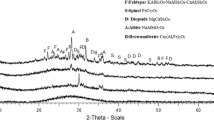Abstract
The devitrification routes of vitrified materials containing chromium-loaded ash were studied in this work. Chromium-loaded ash originates from the incineration of tannery sludge. Vitrification was applied using SiO2, Na2O and CaO. Three different batch compositions were studied with the relative proportions of SiO2 and Na2O kept constant, and varying proportions of chromium-loaded ash and CaO. All vitrified products were thermally treated in order to produce glass–ceramic materials, i.e. to induce devitrification. Thermal treatment temperatures were selected by application of differential thermal analysis. All products were characterized with X-ray diffraction, scanning electron microscopy and energy dispersive spectrometry. The resulting glass–ceramic products possessed different microstructures, i.e. composition, morphology and spatial distribution of separated ceramic phases, depending on the chromium-loaded ash content and thermal treatment temperature. The results show that a combination of differential thermal analysis with morphological, structural and elemental characterization methods renders microstructural tailoring and control of physical properties feasible.






Similar content being viewed by others
References
Colombo P, Brusatin G, Bernardo E, Scarinci G. Inertization and reuse of waste materials by vitrification and fabrication of glass-based products. Curr Opin Solid State Mater Sci. 2003;7:225–39.
LaGrega MD, Buckingham PL, Evans JC. Hazardous waste management. 2nd ed. New York: McGraw Hill; 2001.
Kavouras P, Kaimakamis G, Ioannidis Th, Kehagias Th, Komninou Ph, Kokkou S, Pavlidou E, Antonopoulos I, Sofoniou M, Zouboulis AI, Hadjiantoniou CP, Prakouras A, Karakostas Th. Vitrification of lead-rich solid ashes from incineration of hazardous industrial wastes. Waste Manag. 2003;23:361–71.
Conner JR, Hoeffner SL. A critical review of stabilization/solidification technology. Crit Rev Environ Sci Technol. 1998;28:397–462.
Dhal B, Thatoi HN, Das NN, Pandey BD. Chemical and microbial remediation of hexavalent chromium from contaminated soil and mining/metallurgical soil waste: a review. J Hazard Mater. 2013;250–151:272–91.
Kavouras P, Komninou P, Chrissafis K, Kaimakamis G, Kokkou S, Paraskevopoulos K, Karakostas T. Microstructural changes of processed vitrified waste products. J Eur Ceram Soc. 2003;23:1305–11.
Kavouras P, Komninou P, Karakostas T. Effect of composition and annealing temperature on the mechanical properties of a vitrified waste. J Eur Ceram Soc. 2004;24:2095–102.
Kavouras P, Pantazopoulou E, Varitis S, Vourlias G, Chrissafis K, Dimitrakopulos GP, Mitrakas M, Zouboulis AI, Karakostas Th, Xenidis A. Incineration of tannery sludge under oxic and anoxic conditions: study of chromium speciation. J Hazard Mater. 2015;283:672–9.
Mirhadi B, Mehdikhani B. The effect of chromium oxide on optical spectroscopy of sodium silicate glasses. J Optoelectron Adv Mater. 2011;13:1067–70.
Strnad Z. Glass-ceramic materials. Amsterdam: Elsevier Science Publishers; 1986.
Shelby JE. Introduction to glass science and technology. London: RSC Paperbacks; 1997.
Pisciella P, Crisucci S, Karamanov A, Pelino M. Chemical durability of glasses obtained by vitrification of industrial wastes. Waste Manag. 2001;21:1–9.
Erol M, Küçükbayrak SO, Ersoy-Meriçboyu A, Öveçoglu ML. Crystallization behaviour of glasses produced from fly ashes. J Europ Ceram Soc. 2001;21:2835–41.
Acknowledgements
This research has been co-financed by the European Union (European Social Fund—ESF) and Greek national funds through the Operational Programme “Education and Lifelong Learning” of the National Strategic Reference Framework (NSRF)—Research Funding Programme: THALES: Reinforcement of the interdisciplinary and/or inter-institutional research and innovation.
Author information
Authors and Affiliations
Corresponding author
Rights and permissions
About this article
Cite this article
Varitis, S., Pavlidou, E., Kavouras, P. et al. Devitrification routes of a vitrified chromium-loaded ash. J Therm Anal Calorim 121, 203–208 (2015). https://doi.org/10.1007/s10973-015-4539-7
Received:
Accepted:
Published:
Issue Date:
DOI: https://doi.org/10.1007/s10973-015-4539-7



